“Spider-Man: No Way Home” Production Designer Darren Gilford on Re-Creating NYC
Spider-Man has always been a proud New Yorker, so naturally, filmmakers planned to shoot a lot of No Way Home in Manhattan. Then COVID hit and pandemic restrictions made it impossible to film on Peter Parker’s actual stomping grounds. Realizing that the Spidey show must go on, production designer Darren Gilford and his team came up with a Plan B for replicating New York locations at Pinewood Studios in Atlanta. “This group of filmmakers, craftsmen, and technicians were so committed,” says Gilford, whose credits include Tron: Legacy, Star Wars: Episode VII – The Force Awakens, and The Kings’ Man. “We were the first ones back under these conditions so we were flying blind, but we felt like trailblazers, laying the foundation for how shows could come back healthy.”
Speaking to The Credits from Atlanta, where he’s now working on Disney’s Haunted Mansion reboot, Gilford reveals a Happy Hogan Easter egg, deconstructs Dr. Strange’s frosty headquarters, and explains how he bounced back from lockdown to design sets for the biggest hit of the pandemic era.
One of the movie’s most fantastical environments belongs to Dr. Strange. His Bleecker Street townhouse looks semi-normal on the outside but inside, it’s this winter wonderland rotunda. What’s the story behind your version of the “Sanctum Santorum”?.
I have to credit production designer Charlie Wood with the Sanctum Sanctorum. He designed it for Doctor Strange and Avengers: Endgame. Because of Covid, we had to change our whole approach. In Pinewood, now rebranded as Trilith Studios, we had five sound stages and ended up doing the Sanctorum right outside the elephant doors in the alleyway between buildings.
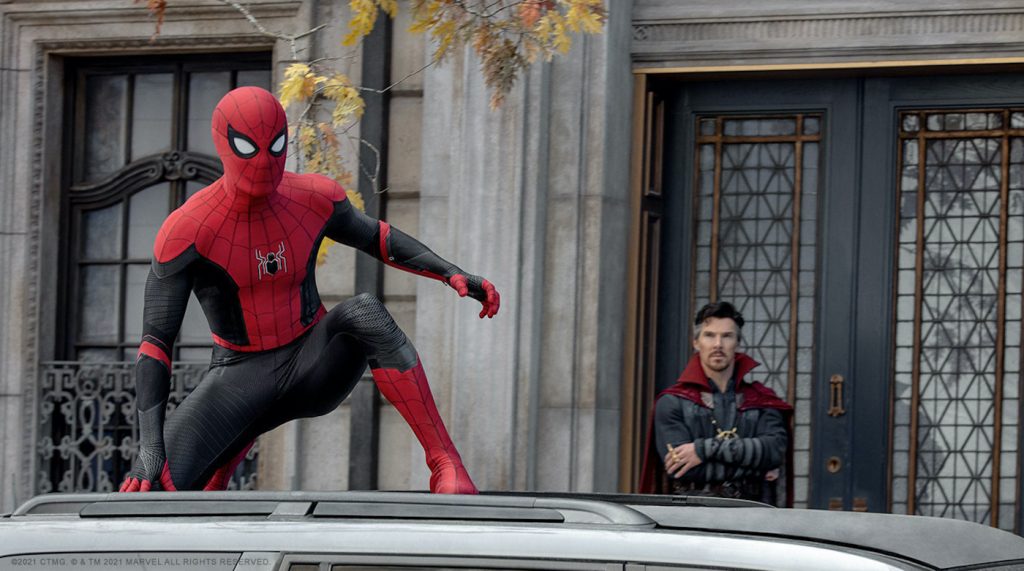
What’s up with all that ice and snow?
We’d seen the Santorum a few times before, so it was really important for [director] Jon [Watts] and [Marvel President] Kevin [Feige] to do something different. We knocked around a bunch of ideas and landed on this crazy weather event where a portal had been left open. We wanted it to look like all the snow was coming from upstairs, blowing down the steps. It was a very wet set, so Ellen Lamp, our lead graphic designer, [3-D] printed the linoleum floor with the same pattern that you would have seen in Endgame. I worked really closely with the VFX team on the snow and ice effects.
And then you’ve got the lower level where Doctor Strange casts the spell that unleashes the multiverse.
We work our way downstairs into what they call the Undercroft. That was our big set, taking up a massive soundstage here at Pinewood. We wanted it to be like your grandma’s basement, that was the joke: old Christmas ornaments, old exercise bicycles, board games, an old refrigerator. My set decorator, Rosemary Brandenburg, really went to town.
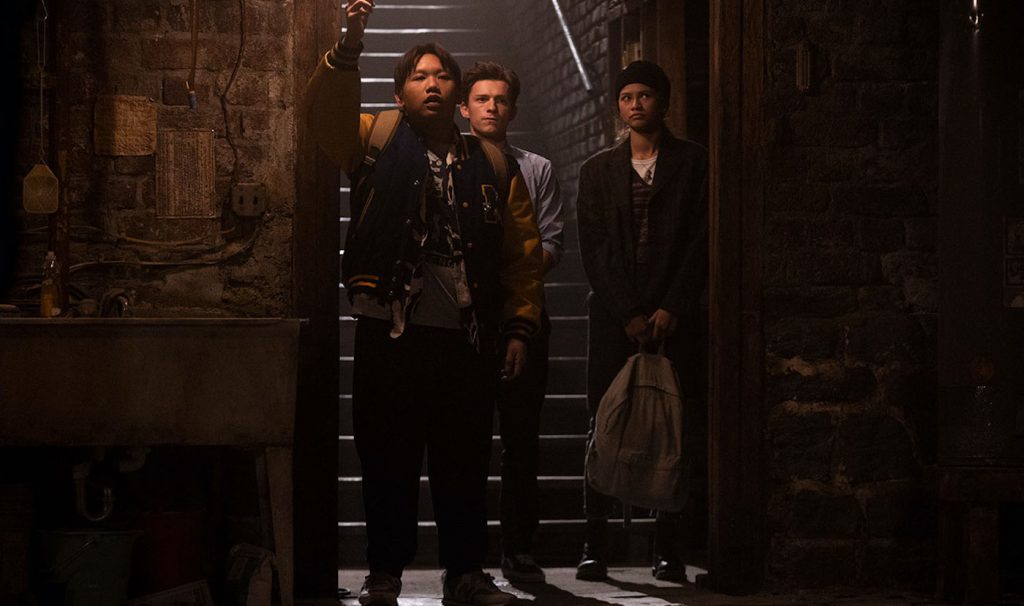
But there’s more.
This aperture opens to the ancient Sanctum. Early on, [designer] Charlie Wood told me it was like the Tardis in Dr. Who, constantly changing. My amazing art director Sam Avila went through all the old Doctor Strange comic books looking for connective tissue, to get a feel for what the set could be. We harvested stuff from that and came up with this concept that monks built the Sanctum back in 1700 when New York was Five Points. We liked the feel of going through this traditional basement to a crazy space of ancient ruins that becomes the [jail] cells for all the villains in the movie.
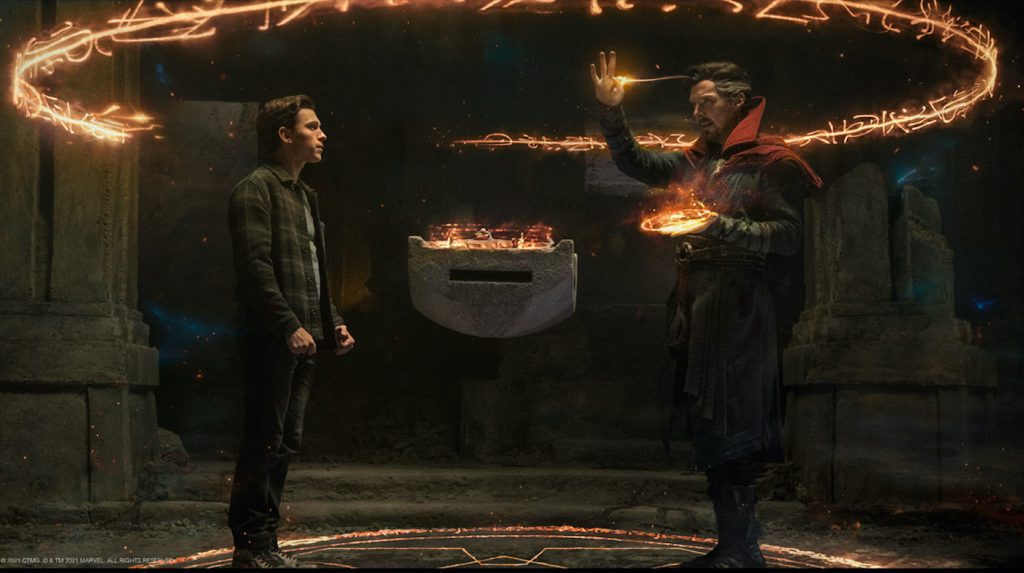
Before Peter Parker makes his way to the Sanctum, he and Aunt May move into Happy Hogan’s bachelor pad. What were you going for there?
Designing Happy Hogan’s place was a blast. We wanted it to feel like a masculine space, super bland, like he’d furnished the entire thing from a catalog. Then we extrapolated from Aunt May’s earthy, patchouli and Birkenstock sensibility and wrapped that into the apartment with scarves hanging over the lamps. We spent a lot of time planting Easter eggs there.
For example?
Way back in one of the Iron Man movies, Robert Downey Jr. mentions that Happy used to be a boxer, so we printed this fight poster with pictures of real boxers. At the bottom on the right side, getting like fifth billing, is this postage-stamp-sized image of Happy Hogan.
Plus, there’s that robot quietly doing tasks in the background.
Yeah, that’s Dummy. He was Tony Stark’s science project in high school, so Dummy’s almost like a pet in a lot of the Iron Man movies. With Tony passing, Happy has taken in Dummy. There’s a quick beat involving the Death Star Lego. Ned dropped it in the first [Tom Holland] movie when he finds out that Peter’s really Spider-Man, so here we have Dummy putting the Death Star back together, which I love. There’s also a fabricator machine in the backroom that winds up being a big story point in the movie.
Just about every Marvel movie involves a magical device of some kind. Here, it’s the glowing cube at Doctor Strange headquarters. What’s it called?
Oh my god, you’re killing me. No, yeah, it’s the major McGuffin in the movie. We just called it The Cube. The design was based on the necklace piece that Doctor Strange wears, which slips my mind at the moment. I’m bad at names, but it belongs to that family of props. On set, it was just a blue box. The cube needed to be animated, so that design got pushed more to visual effects.
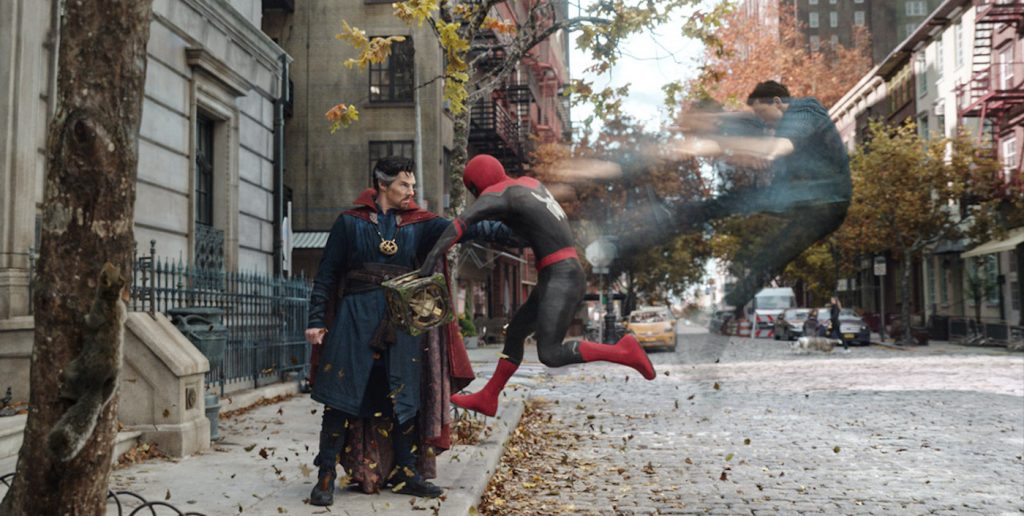
That seems to happen a lot in big movies, where production design becomes almost inseparable from visual effects. The bridge sequence where Doc Ock and his tentacles make their grand entrance, that’s a brick-and-mortar set integrated with CGI?
The Queensboro Bridge was a massive visual effects sequence. But to your point, I come from visual effects. I worked as an art director at Digital Domain. Kelly Port, our visual effects supervisor — we were kids together at Digital Domain and so was Victoria Alonso [now Marvel Studios president, physical and postproduction, visual effects and animation]. Early in my career, I saw a need for designers who could bridge the gap between practical set construction and virtual set construction.
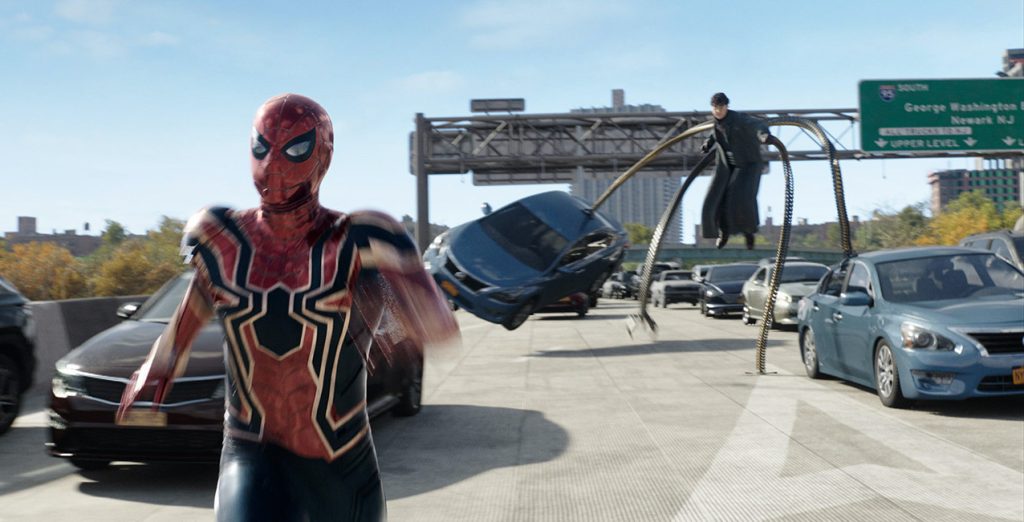
So what kind of physical foundation did you create for that Doc Ock bridge scene?
We built a pretty significant piece of the freeway on ground level at Pinewood constructing this massive exterior three-wall pad site. After we did the freeway set, we struck that and built Happy’s Long Island apartment complex.
You built a freeway?
It was a lot of acreage, but from a construction standpoint, the big question was: “How the hell are we going to get the grooves in the road?” New York bridges have these grooves raked into the concrete. [Construction coordinator] Bob Blackburn came up with this ingenious plan with our plasterers to drag lines through the concrete and make them perfectly symmetrical. It looks just like a machine had done it. You can see in the trailer, when the pumpkin bomb lands, those [hand-raked] grooves provide a great texture.
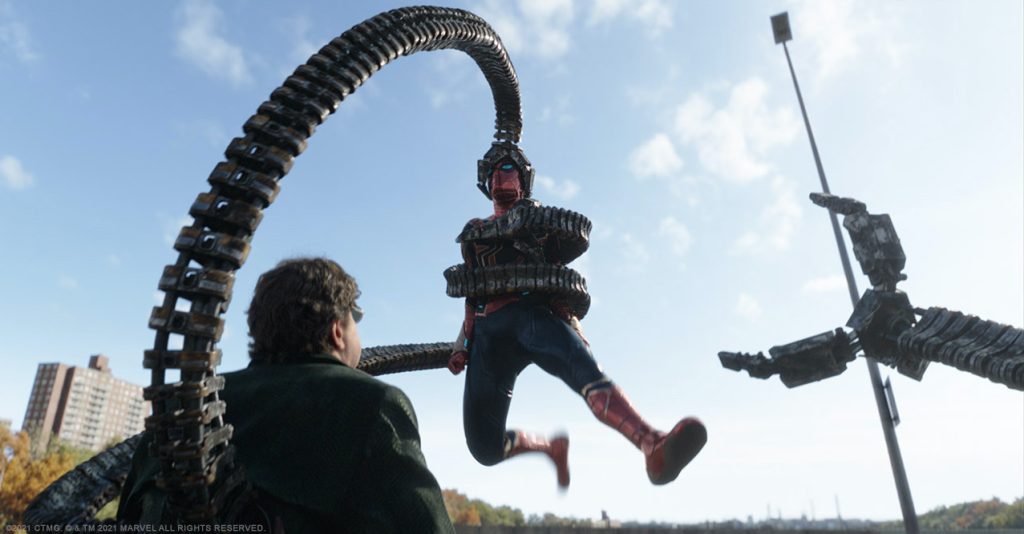
Anything else you’re able to talk about in terms of design challenges in Spider-Man: No Way Home?
To be honest, the most challenging thing was the Covid of it all. We had to turn on a dime, adjust the entire production and work in a completely new paradigm.
Where were you in terms of pre-production when the pandemic hit?
I went to New York to scout locations just as Covid was starting. Nobody was wearing masks yet and I remember being on the subway thinking “This is not cool.” When I got back to L.A., we had to shut down. But within five weeks, all of us working from home with our Zoom accounts. I was literally sitting in front of the computer 12 hours a day making calls with artists from around the world. It was nuts.
Then what happened?
We got the go-ahead to come back to the office. Everyone had to eat lunch in their offices. No craft services. No big meetings. Then we moved to the studio, testing every day and figuring out that whole rigamarole.
But you pulled through.
Because everybody had the right attitude. We were incredibly strict and diligent, and that made for a camaraderie like no other film I’ve ever been on. Across the board, I’ve never been on a film where there’s been so much compassion and understanding and patience.
For more on Spider-Man: No Way Home, check out these stories:
“Spider-Man: No Way Home” Co-Writers Talk Villains, Peter Parker & Changing the Script
“Spider-Man: No Way Home” & The Character Sharing Deal That Lets Spidey Swing From Sony to Marvel
“Spider-Man: No Way Home” Review Round-Up: Most Thrilling Marvel Film Since “Avengers: Endgame”
New “Spider-Man: No Way Home” Footage Gives Glimpse of Green Goblin’s New Suit
Featured image: Tom Holland is Spider-Man and Zendaya is MJ in “Spider-Man: No Way Home.” Courtesy Sony Pictures.



